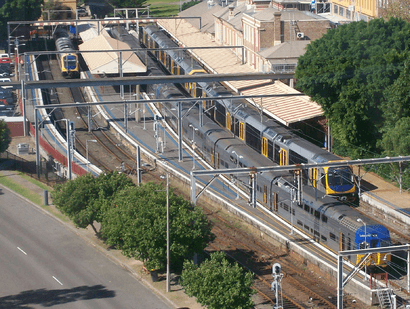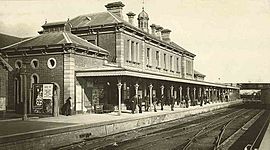Newcastle railway station, New South Wales facts for kids
Quick facts for kids
Newcastle railway station
|
|
|---|---|

Station in May 2012
|
|
| Location | Corner Scott & Watt Streets, Newcastle Australia |
| Coordinates | 32°55′35″S 151°47′01″E / 32.926432°S 151.783644°E |
| Owned by | Transport Asset Holding Entity |
| Operated by | NSW TrainLink |
| Line(s) | Newcastle |
| Distance | 168.10 km (104.45 mi) from Central |
| Platforms | 4 (2 side, 1 island) |
| Tracks | 4 |
| Construction | |
| Structure type | Ground |
| Disabled access | Yes |
| Other information | |
| Status | Closed |
| Station code | NTL |
| Website | Sydney Trains |
| History | |
| Opened | 9 March 1858 |
| Rebuilt | 1878 |
| Electrified | Yes |
| Traffic | |
| Passengers (2013) | 1,150 (daily) (Sydney Trains, NSW TrainLink) |
| Rank | 150 |
|
Building details
|
|

Newcastle railway station, in 1884.
|
|
| Design and construction | |
| Architect | John Whitton |
| Official name: Newcastle Railway Station | |
| Designated: | 2 April 1999 |
| Reference #: | 00236 |
The Newcastle railway station was a very important train station in Newcastle, Australia. It was the main station and the end of the Newcastle railway line for many years.
This historic station building was built in 1878. A famous architect named John Whitton oversaw its construction. The station is now listed on the New South Wales State Heritage Register, which means it's a special building protected for its history.
In September 2018, the old station area was reopened as a community space called The Station. It's now a place for people to gather and enjoy.
Contents
History of the Station
When Did Newcastle Station Open?
The very first Newcastle station was located at Honeysuckle Point. People in Newcastle wanted the train line to go further into the city centre. So, in 1857, a plan was approved to extend the line.
The new station, which is the one we know today, officially opened on 9 March 1858. It replaced the temporary station that was near what is now Civic station. A large area for goods trains was also built east of the station in 1858.
How the Station Was Built
When the train line from the Hunter Valley finally connected to Sydney, a new main station was needed. John Whitton, who was the chief engineer for the NSW Government Railways, led the building of this new station.
The first part of the current building was finished in 1878. It had a two-storey main building with smaller single-storey sections on each side. The ground floor had a ticket office, waiting rooms, and the stationmaster's office. Offices were on the first floor. This design was common for train stations in New South Wales at the time.
Changes Over the Years
As train travel became more popular, the station grew. In 1880, Platform 2 was extended, and a roof was added in 1892. New offices were built, and some old office spaces became a dining room and bar.
In 1897, big changes happened again. A part of the building was removed, and a new two-storey kitchen and staff area were built. A large dining room, called a Railway Refreshment Room (RRR), was also added. This was the last big RRR built in the state.
Between 1923 and 1929, more updates were made. The original porch facing Scott Street was replaced with a brick structure. The dining room was also made into a three-storey building. Many of the inside walls and stairs were built during this time.
Some smaller changes were made in the 1940s and 1950s. The last major work before the station closed happened in 1980.
The Station's Closure
On 20 September 1987, the diesel train repair area was moved to Broadmeadow. This old area was later turned into a bus station and park.
In December 2014, many people protested against the plan to shorten the train line. Despite legal challenges, work began to remove the train tracks between Wickham and Newcastle stations. This was done to make way for the Newcastle Light Rail.
The very last train left Newcastle station for Gosford at 11:27 PM on 25 December 2014. After this, the station officially closed.
What the Station Looks Like
The Newcastle railway station was built with five brick buildings in a row. The main ticket hall in the middle has a special roof and corner sections. The whole station is connected by roofs over the platforms, which are held up by fancy brackets.
The buildings share similar designs, like curved windows and special stone blocks on the corners. This gives the station a classic, old-fashioned look. The buildings on either side of the main hall have raised skylights, which make the roofline interesting. One of these buildings was even turned into a three-storey hotel for a while, which changed its original look.
Platforms and Services
Newcastle Station had four platforms. Two platforms were used for trains going to the Central Coast & Newcastle Line, and two were for trains on the Hunter Line. However, any train could use any platform if needed.
All four train lines at the station were made electric in 1984. The station was also a major place where buses and coaches picked up and dropped off passengers.
Why is it a Heritage Site?
The Newcastle railway station is very important to the history of New South Wales. It shows how the state's second-largest city developed over almost 150 years. It also represents how train travel expanded into regional areas and connected the northern part of the state.
The station is a great example of the type of train station built for larger towns in New South Wales. It's a beautiful example of Victorian-era station design.
The station has a special place in the lives of people from Newcastle for over a century. It can also help us learn more about how train travel changed over time, how the station connected with the harbour, and the history of gas lighting in Newcastle.
The Newcastle railway station was added to the New South Wales State Heritage Register on 2 April 1999.
Gallery
Images for kids











